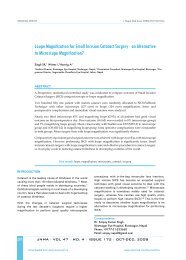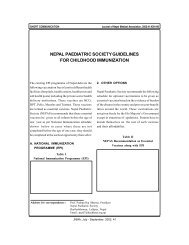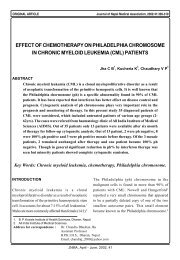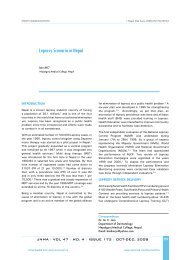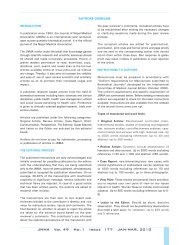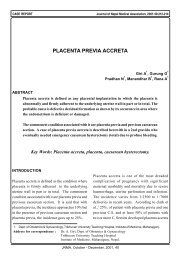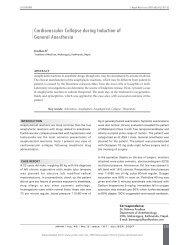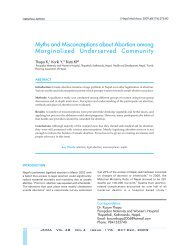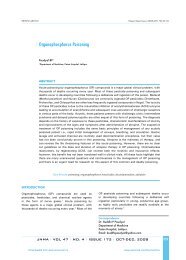Retinal Detachment Surgery at Nepal Eye Hospital - Journal of ...
Retinal Detachment Surgery at Nepal Eye Hospital - Journal of ...
Retinal Detachment Surgery at Nepal Eye Hospital - Journal of ...
You also want an ePaper? Increase the reach of your titles
YUMPU automatically turns print PDFs into web optimized ePapers that Google loves.
ORIGINAL ARTICLE J <strong>Nepal</strong> Med Assoc 2009;48(174):107-10<strong>Retinal</strong> <strong>Detachment</strong> <strong>Surgery</strong> <strong>at</strong> <strong>Nepal</strong> <strong>Eye</strong> <strong>Hospital</strong>Malla OK, 1 Shrestha S, 1 Shrestha SP, 1 Byanju RN, 1 Karki DB 11Department <strong>of</strong> Ophthalmology, K<strong>at</strong>hmandu Medical College, Sinamangal, K<strong>at</strong>hmandu, <strong>Nepal</strong>ABSTRACTIntroduction: <strong>Retinal</strong> diseases are one <strong>of</strong> the important causes <strong>of</strong> blindness in <strong>Nepal</strong>. This study isdone with objectives <strong>of</strong> finding the outcome <strong>of</strong> retinal detachment surgery.Methods: A retrospective analysis <strong>of</strong> 110 p<strong>at</strong>ients who underwent retinal detachment surgery overfive year period was conducted in <strong>Nepal</strong>.Results: <strong>Retinal</strong> re-<strong>at</strong>tachment was achieved in 94.4 % and postoper<strong>at</strong>ive visual acuity <strong>of</strong> 6/36 to 6/6was achieved in 52.7% (As possible risk factors, myopia was present in 34.5% ophkia in 29%, traumain 9%, and l<strong>at</strong>tice) degener<strong>at</strong>ion was 5.4%.Conclusions: The study has shown a promising result for the retinal detachment surgery.Key Words: retinal break, retinal detachment, scleral buckling, vitrectomyINTRODUCTIONThe 1981 blindness survey revealed retinal diseases asone <strong>of</strong> the important causes <strong>of</strong> blindness in <strong>Nepal</strong>. Theincidence <strong>of</strong> rhegm<strong>at</strong>ogenous retinal detachment in thegeneral popul<strong>at</strong>ion is approxim<strong>at</strong>ely 1 in 10,000. 1Tre<strong>at</strong>ment for retinal detachment started withignipuncture by Gonin in 1921 2 followed by cryotherapyin 1930s 3,4 and photocoagul<strong>at</strong>ion in 1960 5 forchorioretinal adhesion. Introduction <strong>of</strong> scleral bucklingsurgery was done in 1950s and 1960s th<strong>at</strong> raised thelikelihood <strong>of</strong> successful surgical outcome from less than50% to 80% or more. 6Vitrectomy is usually done however, pneum<strong>at</strong>icretinopexy may be elected when there are smallretinal breaks in the retinal detachment. 7-9 Even Linc<strong>of</strong>fballoon technique 10 has been used for small peripheraldetachments around a single break with minimalsubretinal fluid.This study aims to review results <strong>of</strong> retinal detachmentsurgery during early phases <strong>of</strong> such service in <strong>Nepal</strong>.METHODSA retrospective study was conducted in <strong>Nepal</strong> <strong>Eye</strong><strong>Hospital</strong>, K<strong>at</strong>hmandu from 1989 to 1994. <strong>Hospital</strong>permission was taken for the study. All the p<strong>at</strong>ients whopresented with rhegm<strong>at</strong>ogenous retinal detachment overthe study period were included in the study. P<strong>at</strong>ientswith exud<strong>at</strong>ive and tractional retinal detachment wereexcluded from the study.The details <strong>of</strong> name, age, sex, dur<strong>at</strong>ion and type <strong>of</strong>symptoms and previous history <strong>of</strong> ocular trauma wasnoted. D<strong>at</strong>a collection and st<strong>at</strong>istical analysis was doneby Micros<strong>of</strong>t <strong>of</strong>fice excel 2003.RESULTSTotal 110 p<strong>at</strong>ients underwent retinal detachmentsurgery for rhegm<strong>at</strong>ogenous retinal detachment. TheCorrespondence:Dr. OK Malla<strong>Nepal</strong> <strong>Eye</strong> <strong>Hospital</strong>K<strong>at</strong>hmandu, <strong>Nepal</strong>.Email: eyehospital@mos.com.npJNMA I VOL 48 I NO. 2 I ISSUE 174 I APR-JUN, 2009 107
Malla et al. <strong>Retinal</strong> <strong>Detachment</strong> <strong>Surgery</strong> <strong>at</strong> <strong>Nepal</strong> <strong>Eye</strong> <strong>Hospital</strong>most common age group being 51-70 years (40.1%)and were less common after 70 years <strong>of</strong> age (9.1%).No cases <strong>of</strong> retinal detachment occurred before theage <strong>of</strong> 10 years (Table 1). Male (63.6%) exceeded thefemale (36.6%) in the study (n=70).Table 1. Distribution <strong>of</strong> p<strong>at</strong>ients according to agegroupAge (year) Number (%)
Malla et al. <strong>Retinal</strong> <strong>Detachment</strong> <strong>Surgery</strong> <strong>at</strong> <strong>Nepal</strong> <strong>Eye</strong> <strong>Hospital</strong>78.2% (n=86) p<strong>at</strong>ients presented with partial retinaldetachment and 21.8% (n=24) has total detachment.Only 1.8% (n=2) p<strong>at</strong>ients had <strong>at</strong>tached macula <strong>at</strong>present<strong>at</strong>ion (Table 6).Table 6. Distribution <strong>of</strong> size <strong>of</strong> retinal detachmentSize <strong>of</strong> retinal detachment Number (%)Total 24 (21.8)More than half 50 (45.4)Less than half 36 (32.8)Total 110 (100)Scleral buckling was done in the form <strong>of</strong> radialplomb(20%), circumferential plomb(27.3%), radial plombwith encirclage(23.6%), tyre with encirclage(9.1%)and encirclage only(20%). Similarly, subretinal fluiddrainage was done in 94.5% <strong>of</strong> cases.<strong>Retinal</strong> re<strong>at</strong>tachment was achieved in 94.4% (n=106)p<strong>at</strong>ients. Post-oper<strong>at</strong>ive visual acuity <strong>of</strong> 6/36 to 6/6was achieved in 52.7% (n=58) p<strong>at</strong>ients.DISCUSSIONAmong 110 cases <strong>of</strong> retinal detachment tre<strong>at</strong>ed withscleral buckling by a single surgeon over the period <strong>of</strong>five years the male female r<strong>at</strong>io was 1.7:1 in the presentstudy. A study conducted by Wong et al 11 and Jon<strong>at</strong>hanet al 12 also found a higher risk <strong>of</strong> rhegm<strong>at</strong>ogenous retinaldetachment in men than women.<strong>Retinal</strong> detachment was found most commonly in theage group 51-70 years in the present study. Jon<strong>at</strong>hanet al 12 and Haimann et al 13 also found an associ<strong>at</strong>ionbetween risk <strong>of</strong> rhegm<strong>at</strong>ogenous retinal detachmentand increasing age.In the present study, 1.8% were pseudophakics and27.2% were aphakics <strong>of</strong> which 5.4% were the oneswho underwent extracapsular c<strong>at</strong>aract extraction while21.8% had undergone intracapsular c<strong>at</strong>aract extraction.In a study done by Jon<strong>at</strong>han et al, pseudophakic andaphakic rhegm<strong>at</strong>ogenous retinal detachments comprised19% <strong>of</strong> the total rhegm<strong>at</strong>ogenous retinal detachmentcases. 12Aphakic and pseudophakic confer a moder<strong>at</strong>e reductionin the r<strong>at</strong>e <strong>of</strong> re<strong>at</strong>tachment. Traditionally, aphakic hasbeen associ<strong>at</strong>ed with significant reduction in an<strong>at</strong>omicsuccess. R<strong>at</strong>es <strong>of</strong> 85 to 95% have been achieved.A single U/horseshoe tear was seen in 51% <strong>of</strong> casesin this study. However, in a study by Comer M. B etal 14 , 76% <strong>of</strong> the retinal breaks were <strong>of</strong> horseshoe typetears while in a study by Shrestha et al, 15 42% hadhorseshoe type <strong>of</strong> retinal break.A major determinant <strong>of</strong> postoper<strong>at</strong>ive visual acuity isthe st<strong>at</strong>us <strong>of</strong> the macula. Macular detachment <strong>of</strong> anydur<strong>at</strong>ion, even 1 day results in reduced postoper<strong>at</strong>iveacuity. Overall, 40 to 50% <strong>of</strong> p<strong>at</strong>ients with maculardetachment achieve, acuity <strong>of</strong> 6/18 or betterpostoper<strong>at</strong>ively.Certain clinical phenomenons are associ<strong>at</strong>ed with agre<strong>at</strong>ly reduced chance <strong>of</strong> success. PVR is the mostcommon such findings, the estim<strong>at</strong>es <strong>of</strong> an<strong>at</strong>omicsuccess in the presence <strong>of</strong> PVR vary from less than50% to more than 75%.Surgical results <strong>of</strong> retinal detachment have improvedconsiderably in the last two decades. 16,17 In thedeveloping countries, the final re<strong>at</strong>tachment r<strong>at</strong>es varyfrom 77-87% with the use <strong>of</strong> modern technology. In astudy done in India, 80 % <strong>of</strong> successfully re<strong>at</strong>tachedretina obtained a vision <strong>of</strong> 6/60 or better. 18,19 In astudy by Shrestha et al 15 , 85.7% had primary surgicalsuccess r<strong>at</strong>e among 42 eyes being tre<strong>at</strong>ed. However, inour study, 96.4% had <strong>at</strong>tached retina <strong>at</strong> the conclusion<strong>of</strong> the surgery. According to a study conducted byComer MB et al 14 , vitreoretinal specialists could achievesuccess r<strong>at</strong>e <strong>of</strong> 90% with a single procedure. 20,21Better preoper<strong>at</strong>ive visual acuity, fewer quadrantinvolvement and lack <strong>of</strong> high myopia were importantprognostic factors for visual acuity in a study doneby Salicone et al 22 nvolving 672 p<strong>at</strong>ients with retinaldetachment while the dur<strong>at</strong>ion <strong>of</strong> macular detachmenthad surprisingly little influence on post oper<strong>at</strong>ive visualacuity. Most authors agree th<strong>at</strong> functional successdepends in part on preoper<strong>at</strong>ive visual acuity and p<strong>at</strong>ientage. The chances <strong>of</strong> restoring good vision decline withadvancing age. 23,24 In the present study, preoper<strong>at</strong>ively49.1% had visual acuity <strong>of</strong> hand movements whilepostoper<strong>at</strong>ively 44% had visual acuity <strong>of</strong> 6/36 to 6/18although 98.2% <strong>of</strong> p<strong>at</strong>ients had macular detachment <strong>at</strong>the time <strong>of</strong> present<strong>at</strong>ion, 14.5% had high myopia and67.2% had involvement <strong>of</strong> more than two quadrants.Similarly, PVR grade C1 or worse was present in 16.3%out <strong>of</strong> the total <strong>of</strong> 21.7%<strong>of</strong> cases with PVR.Postoper<strong>at</strong>ive visual acuity depends on the st<strong>at</strong>us <strong>of</strong> themacula: whether and for how long it was detached beforesurgery. If the macular was detached, degener<strong>at</strong>ion <strong>of</strong>photoreceptors may prevent good postoper<strong>at</strong>ive visualacuity. While 78% <strong>of</strong> eyes with retinal detachmentsparing the macula recovered visual <strong>of</strong> 6/18 or better,only 37% with detachment macular <strong>at</strong>tained th<strong>at</strong> level.In the present study, 98.2% <strong>of</strong> p<strong>at</strong>ients were found tohave macula detached <strong>at</strong> the time <strong>of</strong> present<strong>at</strong>ion andit was not easy for them to specul<strong>at</strong>e the dur<strong>at</strong>ion <strong>of</strong>detachment. 25In our series <strong>of</strong> 110 RRD cases, in almost all casesthere was no indic<strong>at</strong>ion <strong>of</strong> the dur<strong>at</strong>ion <strong>of</strong> maculardetachment.An<strong>at</strong>omical success is achieved in 96.4% <strong>of</strong> p<strong>at</strong>ients,who undergo retinal detachment surgery, butJNMA I VOL 48 I NO. 2 I ISSUE 174 I APR-JUN, 2009 109
Malla et al. <strong>Retinal</strong> <strong>Detachment</strong> <strong>Surgery</strong> <strong>at</strong> <strong>Nepal</strong> <strong>Eye</strong> <strong>Hospital</strong>number <strong>of</strong> p<strong>at</strong>ients who achieve good visual acuityis compar<strong>at</strong>ively less. A number <strong>of</strong> factors have beenidentified for poor visual recovery. It is well establishedfact th<strong>at</strong> visual recovery may occur as long as 2 yearfollowing retinal detachment surgery and recovery isbecause <strong>of</strong> regener<strong>at</strong>ion <strong>of</strong> retinal receptors. Visual losscould be either assigned to rearranged/misalignment <strong>of</strong>retinal receptors and in complete regener<strong>at</strong>ion <strong>of</strong> retinalreceptors. 26Traditionally, aphakia has been associ<strong>at</strong>ed with asignificant reduction in an<strong>at</strong>omic success. R<strong>at</strong>es <strong>of</strong> 85to 95% have been achieved. 25,26 However, in our studyalthough 29% were aphakics, surgical re<strong>at</strong>tachmentwas obtained in 96,4% <strong>of</strong> cases. Similarly, 4o to 50%<strong>of</strong> p<strong>at</strong>ients with macular detachment achieve acuity <strong>of</strong>20/50 or better postoper<strong>at</strong>ively. 23,24,27,28 In the presentstudy, all the p<strong>at</strong>ients had macular detachment <strong>at</strong>present<strong>at</strong>ion and post oper<strong>at</strong>ive visual acuity <strong>of</strong> 6/36 orbetter was achieved in 52.7%.CONCLUSIONSThe study has shown a promising result for the retinaldetachment surgery. We need to have a large size studyto support this finding. Development <strong>of</strong> infrastructureis a must.ACKNOWLEDGEMENTSWe would also like to appreci<strong>at</strong>e the effort <strong>of</strong> Mr.Mukunda Wagle in computer works and <strong>Nepal</strong> <strong>Eye</strong><strong>Hospital</strong> staffs.REFERENCES1. Kanski JJ. Clinical Ophthalmology. 5th ed. USA: utterworth-Heinemann; 2004. P.353-88.2. Gonin J. Le traitementdu ecollement etinien. Ann Ocul (Paris).1921;158:175-194.3. Deutschmann R. Ueber zwei Verfahren bei BehandlungderNetzhautabloesung nebst Bemerkungen Zur Genese desNetzhautrisses und seines Verhaeltnisses zur Entstehung derAbloesung. Klin Mon<strong>at</strong>sbl Augenheilkd. 1933;91:450-6.4. Krawawicz T. Intracapsular extraction <strong>of</strong> intumescentc<strong>at</strong>aract by applic<strong>at</strong>ion <strong>of</strong> low temper<strong>at</strong>ure. Br J Ophthalmol.1961;45:279-83.5. Michels RG, Wilkinson CP, Rice TA. <strong>Retinal</strong> detachment. St.Louis: CV Mosby; 1990.p.294-7.6. Joan Miller J, Azar D, Blodi B. Albert & Jakobiec's Principles& Practice <strong>of</strong> Ophthalmology; vol 3. 3rd ed. USA: Saunders;2008. p. 2359-75.7. Hilton GF, Grizzard WS. Pneum<strong>at</strong>ic retinopexy. A twostepoutp<strong>at</strong>ient oper<strong>at</strong>ion without conjunctival incision.Ophthalmology. 1986 May;93(5):626-41.8. HIlton GF, Kelly NE, Salzano TC, et al: Pneum<strong>at</strong>ic retinopexy:A collabor<strong>at</strong>ive report <strong>of</strong> first 100 cases. Ophthalmology.1987;94:307-14.9. Tornambe PE, HIlton GF, Kelly NF, et al. Expanded indic<strong>at</strong>ionsfor pneum<strong>at</strong>ic retinopexy. Ophthalmology. 1988;95:597-600.10. Linc<strong>of</strong>f HA, Kreissig I, Hahn YS. A temporary balloonbuckle for the tre<strong>at</strong>ment <strong>of</strong> small retinal detachments.Ophthalmology. 1979 Apr;86(4):586-96.11. Wong TY, James MT, Oliver DS, et al. Racial differencein the incidence <strong>of</strong> retinal detachment in Singapore. ArchOphthalmol. 1999;117:379-83.12. John<strong>at</strong>han AR, Jay CE, Keith HB, et al. <strong>Retinal</strong> detachmentin Olmsted County, Minnesota, 1976 through 1995.Ophthalmology. 1999;106:154-9.13. Haimann NH, Burton TC, Brown CK. Epidemology <strong>of</strong> retinaldetachment. Arch <strong>of</strong> Ophthalmol. 1982;100:289-92.14. Comer MB, Newman DK, Martin KR, et al. Who shouldmanage retinal detachments. <strong>Eye</strong>. 2000;14,572-8.15. Wang NK, Chen TL, Lai CC, Kuo YH, Chao AN, Wu WC, etal. Clinical characteristics and surgical outcomes <strong>of</strong> pedi<strong>at</strong>ricretinal detachments with lens disorders. J Pedi<strong>at</strong>r OphthalmolStrabismus. 2009 May-Jun;46(3):160-7.16. Thompson JA, Snead MP, Billington BM, et al. N<strong>at</strong>ional audit<strong>of</strong> the outcomes <strong>of</strong> primary surgery for rhegm<strong>at</strong>ogenousretinal detachment. <strong>Eye</strong>. 2002;16:771-7.17. Johnson Z, Ramsay A, Cottrell D, et al. Triple cycle audit <strong>of</strong>primary retinal detachment surgery. <strong>Eye</strong>. 2002;16(5):513-8.18. Yorston D, Jalali S. <strong>Retinal</strong> detachment in developingcountries. <strong>Eye</strong>. 2002;16:353-8.19. Lewis H, Haberg TM, Abrams GW. Causes <strong>of</strong> failure afterinitial V_R <strong>Surgery</strong> for Severe PVR. AMJ Ophthalmol.111;8(14):1991.20. American Academy <strong>of</strong> Ophthalmology. Retina and vitreous[Online]. [cited 2008 Dec 10]. Available from: URL:http://one.aao.org21. Ed Pasrisha JK, editor. Retina. India: India OphthalmologicalSociety :1998.22. Tani P, Robertson DM, Langworthy A. Prognosis for centralvision and an<strong>at</strong>omic re<strong>at</strong>tachment in rhegm<strong>at</strong>ogenous retinaldetachment with macula detached. Am J Ophthalmol. 1981Nov;92(5):611-20.23. Salicone A, Smiddy WE, Venk<strong>at</strong>raman A, et al. Visual recoveryafter scleral buckling procedure for retinal detachment.Ophthalmology. 2006 Oct;113(10):1734-42.24. Mc Pherson AR, O'MalleyRE, Butner RW, et al. Visualacuity after surgery for retinal detachment with macularinvolvement. Ann Ophthalmol. 1982;14:639-45.25. Norton EWD. <strong>Retinal</strong> <strong>Detachment</strong> in aphakia. Trans AmOphthalmol Soc. 1963;61:770-89.26. O'Connor PR. External buckling without drainage for selecteddetachments in aphakic eyes. Am J Ophthalmol. 1976;82:358-64.27. Grupposo SS. Visual acuity following surgery for retinaldetachment. Arch Ophthalmol. 1975;93:327-30.28. Davidorf FH, Havener WH, Lang JR. Macular vision followingretinal detachment surgery. Ophthalmic Surg. 1975;6(4):74-81.110JNMA I VOL 48 I NO. 2 I ISSUE 174 I APR-JUN, 2009



